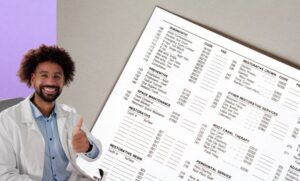Accurate Coding and Billing are vital for physicians to receive appropriate reimbursement for their services and to ensure compliance with healthcare regulations. Documentation plays a crucial role in this process, as it serves as the foundation for coding and billing activities. Optimizing documentation practices is essential for physicians to improve accuracy, efficiency, and revenue generation. This article will provide essential tips for physicians to optimizing their documentation for accurate coding and billing.
Optimizing Documentation for Accurate Coding and Billing
Understand Coding and Billing Guidelines
To optimize documentation, physicians must have a solid understanding of coding and billing guidelines. Familiarize yourself with the Current Procedural Terminology (CPT) codes, International Classification of Diseases (ICD) codes, and any other relevant coding systems. Stay updated with the latest revisions and guidelines to ensure compliance with regulatory requirements.
Document Medical Necessity
One key aspect of accurate coding and billing is documenting medical necessity. Ensure that your documentation clearly justifies the need for the services rendered. Describe the patient’s condition, symptoms, and how the services provided are directly related to their medical care. Medical necessity documentation is crucial for supporting the coding and billing process and preventing denials or audits.
Use Clear and Specific Language
Using clear and specific language in your documentation is essential for accurate coding and billing. Avoid ambiguous terms or abbreviations that may lead to confusion or misinterpretation. Provide detailed descriptions of the patient’s condition, including the severity, duration, and any relevant factors that impact the treatment plan. Clear and specific documentation facilitates accurate coding, reduces coding errors, and ensures proper reimbursement.
These all are the essentials tips for physicians to Optimizing Documentation for Accurate Coding and Billing. So, try these tips for accurate medical claims.
Include Relevant History and Physical Examination Findings
Comprehensive documentation should include relevant history and physical examination findings. Describe the patient’s medical history, including any relevant previous diagnoses, surgeries, or treatments. Document the physical examination findings, such as vital signs, observations, and relevant test results. Including this information supports accurate coding and provides a complete picture of the patient’s condition.
Also Read:
- 5 Ways to enhance older patient experience
- Why does your practice need medical revenue service?
- Challenges Physicians face with medical billing process
Capture the Complexity of Services
Physicians should accurately capture the complexity of services provided. Describe the level of difficulty, time, and effort required to evaluate, diagnose, and treat the patient. Document any complications or additional procedures performed during the encounter. Accurately reflecting the complexity of services ensures appropriate coding and reimbursement for the physician’s expertise.
Avoid Copy-Pasting and Template Pitfalls
While templates and electronic health records (EHRs) can streamline documentation, physicians should avoid the pitfalls of excessive copy-pasting. Reusing previous documentation without customization can result in inaccurate or incomplete records. Take the time to review and update each entry to reflect the current encounter accurately. Personalize the documentation to each patient’s unique circumstances and avoid generic or boilerplate language.
Ensure Proper Coding of Procedures and Diagnoses
Accurate coding of procedures and diagnoses is crucial for optimal reimbursement. Familiarize yourself with the appropriate CPT and ICD codes for each service provided. Stay up-to-date with coding changes and guidelines. Double-check that the documented services align with the selected codes to prevent coding errors or discrepancies. Regular audits and compliance checks can help identify any coding gaps or issues.
Engage in Ongoing Education and Training
Coding and billing regulations are subject to frequent updates. Engaging in ongoing education and training is essential to stay abreast of the latest changes. Attend coding workshops, webinars, and conferences to enhance your coding knowledge. Encourage your staff to receive training as well, ensuring a cohesive approach to accurate documentation and coding within your practice.
Collaborate with Coding and Billing Professionals
Collaborating with coding and billing professionals can greatly enhance accuracy and efficiency. Consult with certified coders and billing experts to ensure your documentation aligns with coding guidelines. These professionals can provide valuable insights and offer guidance on documentation improvement. Regular communication and collaboration with your coding and billing team can help address any coding challenges, resolve coding-related queries, and ensure compliance with billing requirements.
Implement Documentation Improvement Programs
Consider implementing documentation improvement programs within your practice. These programs focus on identifying areas for improvement in documentation practices and providing education and resources to physicians. By actively participating in such programs, physicians can enhance their documentation skills, resulting in more accurate coding and billing.
Conduct Internal Documentation Audits
Regular internal documentation audits can help identify potential areas of improvement and ensure compliance with coding and billing guidelines. Review a sample of patient records periodically to assess the quality of documentation. Look for any inconsistencies, missing information, or areas that need further clarification. Addressing these issues proactively can help minimize errors and improve documentation accuracy.
Communicate Effectively with Coders and Billers
Clear and effective communication between physicians and coding/billing professionals is vital. Provide additional information or clarification when necessary, and promptly respond to any queries from coders and billers. Establish a collaborative relationship that fosters open dialogue and mutual understanding. Regular meetings or huddles can facilitate this communication and help address any documentation-related issues in a timely manner.
Need Assistance?
Optimizing your documentation for accurate medical billing and coding with The Medicator’s expert solutions. Discover the industry-leading techniques and technologies that ensure precision and compliance. Streamline your processes, enhance coding accuracy, and maximize revenue with our trusted services. Partner with The Medicator’s, a leading medical billing and coding company, and unlock the potential for efficient and error-free documentation. Trust our expertise to take your billing and coding practices to the next level.









